基于.net core 2.0+mysql+AceAdmin搭建一套快速开发框架
前言
.net core已经出来一段时间了,相信大家对.net core的概念已经很清楚了,这里就不再赘述。笔者目前也用.net core做过一些项目,并且将以前framework下的一些经验移植到了.net core下,并结合.net core本身的一些特性整理成此框架,以供学习参考。如有不足之处,欢迎指正。
框架介绍
先来一张整体分层结构图
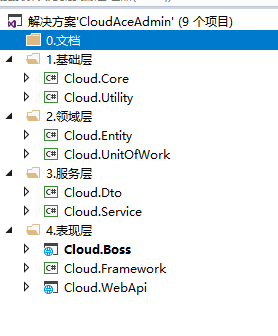
基础层
1.Cloud.Core项目是核心项目,主要实现缓存的操作、dapper操作、EF Repository、PageList、日志等操作
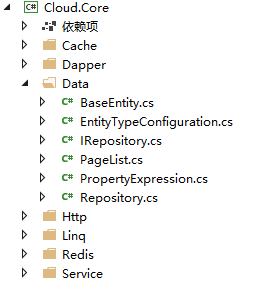
2.Cloud.Utility属于帮助类
领域层
3.Cloud.Entity实体对象,存放数据库映射实体、Fluent API配置、枚举字典、DbContext等
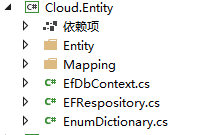
4.Cloud.UnitOfWork,操作数据库的网关,里面封装了对仓储的操作、dapper的操作、事务等
服务层
5.Cloud.Service 业务逻辑的实现
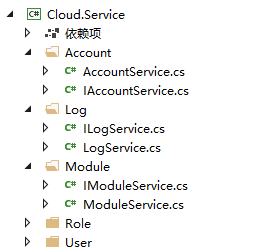
6.Cloud.Dto 数据传输对象,实体对象不直接和表现层接触,通过dto互转
表现层
7.Cloud.Framework,表现层框架,封装了超类controller,全局授权过滤器,全局异常过滤器,ActionFilter,HtmlHelper等操作

8.Cloud.Boss 启动项目
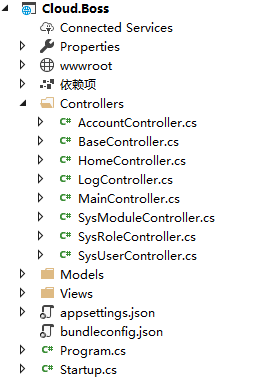
使用的技术
基于.net core 2.0的asp.net core mvc
基于.net core 2.0的ef
dapper
mysql
前端框架 aceAdmin
技术要点
1.实体基类定义
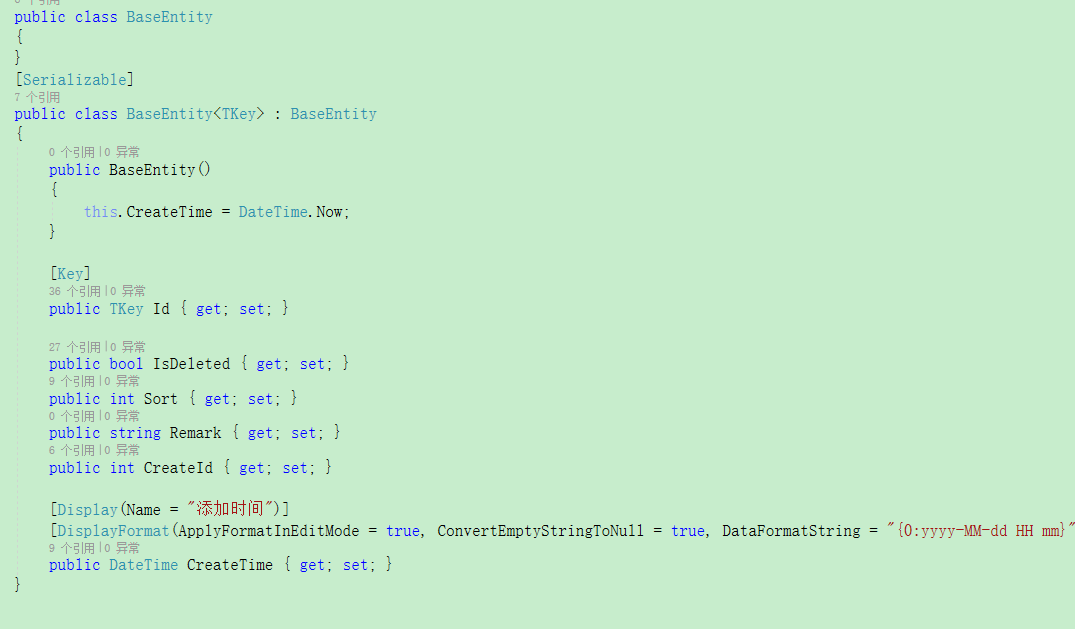
2.泛型仓储的封装
2.1仓储接口的定义,泛型约束T必须是BaseEntity类型
public interface IRepository<T> where T : BaseEntity
{
DatabaseFacade Database { get; }
IQueryable<T> Entities { get; }
int SaveChanges();
Task<int> SaveChangesAsync();
void Disposed();
bool Delete(List<T> entitys, bool isSaveChange = true);
bool Delete(T entity, bool isSaveChange = true);
Task<bool> DeleteAsync(List<T> entitys, bool isSaveChange = true);
Task<bool> DeleteAsync(T entity, bool isSaveChange = true);
Task<T> GetAsync(Expression<Func<T, bool>> predicate = null);
Task<List<T>> GetListAsync(Expression<Func<T, bool>> predicate = null);
T Get(object id);
T Get(Expression<Func<T, bool>> predicate = null);
Task<T> GetAsync(object id);
Task<IQueryable<T>> LoadAsync(Expression<Func<T, bool>> predicate = null);
bool Insert(List<T> entitys, bool isSaveChange = true);
bool Insert(T entity, bool isSaveChange = true);
Task<bool> InsertAsync(List<T> entitys, bool isSaveChange = true);
Task<bool> InsertAsync(T entity, bool isSaveChange = true);
bool Update(List<T> entitys, bool isSaveChange = true);
bool Update(T entity, bool isSaveChange = true, List<string> updatePropertyList = null);
Task<bool> UpdateAsync(List<T> entitys, bool isSaveChange = true);
Task<bool> UpdateAsync(T entity, bool isSaveChange = true, List<string> updatePropertyList = null);
}
2.2仓储接口的实现
public class Repository<T> : IRepository<T> where T : BaseEntity
{
DbContext _dbContext;
public Repository(DbContext dbContext)
{
_dbContext = dbContext;
}
public int SaveChanges()
{
return _dbContext.SaveChanges();
}
public async Task<int> SaveChangesAsync()
{
return await _dbContext.SaveChangesAsync();
}
public void Disposed()
{
throw new Exception("不允许在这里释放上下文,请在UnitOfWork中操作");
_dbContext.Dispose();
}
#region 插入数据
public bool Insert(T entity, bool isSaveChange = true)
{
_dbContext.Set<T>().Add(entity);
if (isSaveChange)
{
return SaveChanges() > 0;
}
return false;
}
public async Task<bool> InsertAsync(T entity, bool isSaveChange = true)
{
_dbContext.Set<T>().Add(entity);
if (isSaveChange)
{
return await SaveChangesAsync() > 0;
}
return false;
}
public bool Insert(List<T> entitys, bool isSaveChange = true)
{
_dbContext.Set<T>().AddRange(entitys);
if (isSaveChange)
{
return SaveChanges() > 0;
}
return false;
}
public async Task<bool> InsertAsync(List<T> entitys, bool isSaveChange = true)
{
_dbContext.Set<T>().AddRange(entitys);
if (isSaveChange)
{
return await SaveChangesAsync() > 0;
}
return false;
}
#endregion
#region 更新数据
public bool Update(T entity, bool isSaveChange = true, List<string> updatePropertyList = null)
{
if (entity==null)
{
return false;
}
_dbContext.Set<T>().Attach(entity);
if (updatePropertyList==null)
{
_dbContext.Entry<T>(entity).State = EntityState.Modified;//全字段更新
}
else
{
updatePropertyList.ForEach(c => {
_dbContext.Entry(entity).Property(c).IsModified = true; //部分字段更新的写法
});
}
if (isSaveChange)
{
return SaveChanges() > 0;
}
return false;
}
public bool Update(List<T> entitys, bool isSaveChange = true)
{
if (entitys==null||entitys.Count==0)
{
return false;
}
entitys.ForEach(c => {
Update(c, false);
});
if (isSaveChange)
{
return SaveChanges() > 0;
}
return false;
}
public async Task<bool> UpdateAsync(T entity, bool isSaveChange = true, List<string> updatePropertyList = null)
{
if (entity == null)
{
return false;
}
_dbContext.Set<T>().Attach(entity);
if (updatePropertyList == null)
{
_dbContext.Entry<T>(entity).State = EntityState.Modified;//全字段更新
}
else
{
updatePropertyList.ForEach(c => {
_dbContext.Entry(entity).Property(c).IsModified = true; //部分字段更新的写法
});
}
if (isSaveChange)
{
return await SaveChangesAsync() > 0;
}
return false;
}
public async Task<bool> UpdateAsync(List<T> entitys, bool isSaveChange = true)
{
if (entitys == null || entitys.Count == 0)
{
return false;
}
entitys.ForEach(c => {
_dbContext.Set<T>().Attach(c);
_dbContext.Entry<T>(c).State = EntityState.Modified;
});
if (isSaveChange)
{
return await SaveChangesAsync() > 0;
}
return false;
}
#endregion
#region 删除
public bool Delete(T entity, bool isSaveChange = true)
{
_dbContext.Set<T>().Attach(entity);
_dbContext.Set<T>().Remove(entity);
return isSaveChange ? SaveChanges() > 0 : false;
}
public bool Delete(List<T> entitys, bool isSaveChange = true)
{
entitys.ForEach(entity =>
{
_dbContext.Set<T>().Attach(entity);
_dbContext.Set<T>().Remove(entity);
});
return isSaveChange ? SaveChanges() > 0 : false;
}
public virtual async Task<bool> DeleteAsync(T entity, bool isSaveChange = true)
{
_dbContext.Set<T>().Attach(entity);
_dbContext.Set<T>().Remove(entity);
return isSaveChange ? await SaveChangesAsync() > 0 : false;
}
public virtual async Task<bool> DeleteAsync(List<T> entitys, bool isSaveChange = true)
{
entitys.ForEach(entity =>
{
_dbContext.Set<T>().Attach(entity);
_dbContext.Set<T>().Remove(entity);
});
return isSaveChange ? await SaveChangesAsync() > 0 : false;
}
#endregion
public IQueryable<T> Entities => _dbContext.Set<T>().AsQueryable().AsNoTracking();
//public async Task<IQueryable<T>> EntitiesAsync => Task.Run(()=> _dbContext.Set<T>().AsQueryable().AsNoTracking());
public DatabaseFacade Database => _dbContext.Database;
#region 查找
public T Get(object id)
{
return _dbContext.Set<T>().Find(id);
}
public T Get(Expression<Func<T, bool>> predicate = null)
{
return _dbContext.Set<T>().Where(predicate).AsNoTracking().FirstOrDefault();
}
public async Task<T> GetAsync(object id)
{
return await _dbContext.Set<T>().FindAsync(id);
}
public async Task<T> GetAsync(Expression<Func<T, bool>> predicate = null)
{
return await _dbContext.Set<T>().Where(predicate).AsNoTracking().FirstOrDefaultAsync();
}
public async Task<List<T>> GetListAsync(Expression<Func<T, bool>> predicate = null)
{
return await _dbContext.Set<T>().Where(predicate).AsNoTracking().ToListAsync();
}
public async Task<IQueryable<T>> LoadAsync(Expression<Func<T, bool>> predicate = null)
{
if (predicate == null)
{
predicate = c => true;
}
return await Task.Run(() => _dbContext.Set<T>().Where(predicate).AsNoTracking());
}
public void Dispose()
{
throw new NotImplementedException();
}
#endregion
}
3.表部分字段更新实现
EF默认的更新方式是一个实体对应的表全部字段更新,那么我们想更新表的部分字段怎么处理?
首先定义需要更新的字段:
public class PropertyExpression<T> where T : BaseEntity
{
private PropertyExpression() { }
private static List<string> propertyList = new List<string>();
public static PropertyExpression<T> Init
{
get
{
propertyList.Clear();
return new PropertyExpression<T>();
}
}
public PropertyExpression<T> Property(Expression<Func<T, object>> expr)
{
var rtn = "";
if (expr.Body is UnaryExpression)
{
rtn = ((MemberExpression)((UnaryExpression)expr.Body).Operand).Member.Name;
}
else if (expr.Body is MemberExpression)
{
rtn = ((MemberExpression)expr.Body).Member.Name;
}
else if (expr.Body is ParameterExpression)
{
rtn = ((ParameterExpression)expr.Body).Type.Name;
}
propertyList.Add(rtn);
return this;
}
public List<string> ToList()
{
return propertyList;
}
}
EF更新的处理
public bool Update(T entity, bool isSaveChange = true, List<string> updatePropertyList = null)
{
if (entity==null)
{
return false;
}
_dbContext.Set<T>().Attach(entity);
if (updatePropertyList==null)
{
_dbContext.Entry<T>(entity).State = EntityState.Modified;//全字段更新
}
else
{
updatePropertyList.ForEach(c => {
_dbContext.Entry(entity).Property(c).IsModified = true; //部分字段更新的写法
});
}
if (isSaveChange)
{
return SaveChanges() > 0;
}
return false;
}
使用
var entity = _unitOfWork.SysRoleRep.Get(model.RoleId);
if (entity == null)
{
throw new Exception("要查找的对象不存在");
}
entity.Name = model.RoleName;
var updatedPropertyList = PropertyExpression<Sys_Role>.Init.Property(c => c.Name).ToList();
_unitOfWork.SysRoleRep.Update(entity, true, updatedPropertyList);
4.动态加载实体到DbContext
public class EntityTypeConfiguration<T> : IEntityTypeConfiguration<T> where T : class
{
public void Configure(EntityTypeBuilder<T> builder)
{
RelyConfigure(builder);
}
public virtual void RelyConfigure(EntityTypeBuilder<T> builder)
{
}
}
public class Sys_Error_LogConfiguration : EntityTypeConfiguration<Sys_Error_Log>
{
public override void RelyConfigure(EntityTypeBuilder<Sys_Error_Log> builder)
{
builder.ToTable("sys_error_log");
builder.HasKey(x => x.Id);
base.RelyConfigure(builder);
}
}
public class EfDbContext : DbContext
{
public EfDbContext(DbContextOptions<EfDbContext> options) : base(options)
{
}
//配置数据库连接
protected override void OnConfiguring(DbContextOptionsBuilder optionsBuilder)
{
// optionsBuilder.UseSqlServer("xxxx connection string");
base.OnConfiguring(optionsBuilder);
}
//第一次使用EF功能时执行一次,以后不再执行
protected override void OnModelCreating(ModelBuilder modelBuilder)
{
//获取当前程序集中有基类并且基类是泛型的类
var typesToRegister = Assembly.GetExecutingAssembly().GetTypes().Where(c => c.BaseType != null && c.BaseType.IsGenericType).ToList();
foreach (var type in typesToRegister)
{
//泛型定义相同
if (type.BaseType.GetGenericTypeDefinition() == typeof(EntityTypeConfiguration<>))
{
dynamic configurationInstance = Activator.CreateInstance(type);
modelBuilder.ApplyConfiguration(configurationInstance);
}
}
base.OnModelCreating(modelBuilder);
}
}
5.工作单元
工作单元是对仓储和事务的封装
原理参考:https://docs.microsoft.com/zh-cn/aspnet/mvc/overview/older-versions/getting-started-with-ef-5-using-mvc-4/implementing-the-repository-and-unit-of-work-patterns-in-an-asp-net-mvc-application
public class EfUnitOfWork : IUnitOfWork
{
private EfDbContext _dbContext;//每次请求上下文只会创建一个
public EfUnitOfWork(EfDbContext context)
{
this._dbContext = context;
}
public int SaveChanges()
{
return _dbContext.SaveChanges();
}
public async Task<int> SaveChangesAsync()
{
return await _dbContext.SaveChangesAsync();
}
private bool disposed = false;
protected virtual void Dispose(bool disposing)
{
if (!this.disposed)
{
if (disposing)
{
_dbContext.Dispose();//随着工作单元的销毁而销毁
}
}
this.disposed = true;
}
public void Dispose()
{
Dispose(true);
GC.SuppressFinalize(this);
}
public IDbContextTransaction BeginTransaction()
{
var scope = _dbContext.Database.BeginTransaction();
return scope;
}
public List<T> SqlQuery<T>(string sql, object param = null) where T : class
{
var con= _dbContext.Database.GetDbConnection();
if (con.State!= ConnectionState.Open)
{
con.Open();
}
var list= MysqlDapperReader.SqlQuery<T>(con, sql, param);
return list;
//throw new NotImplementedException();
}
public Task<List<T>> SqlQueryAsync<T>(string sql, object param = null) where T : class
{
throw new NotImplementedException();
}
#region Sys Repository
private IRepository<Sys_User> _sysUserRep;
public IRepository<Sys_User> SysUserRep
{
get
{
if (_sysUserRep == null)
{
//var s= HttpContext.Current.Items["currentUser"];
//var s = HttpContext.Current.RequestServices.GetService<IRepository<Sys_User>>();
//HttpContext.RequestServices.GetService<IRepository<Sys_User>>();
_sysUserRep = new Repository<Sys_User>(_dbContext);
}
return _sysUserRep;
}
}
private IRepository<Sys_Role> _sysRoleRep;
public IRepository<Sys_Role> SysRoleRep
{
get
{
if (_sysRoleRep == null)
{
_sysRoleRep = new Repository<Sys_Role>(_dbContext);
}
return _sysRoleRep;
}
}
private IRepository<Sys_Role_User> _sysRoleUserRep;
public IRepository<Sys_Role_User> SysRoleUserRep
{
get
{
if (_sysRoleUserRep == null)
{
_sysRoleUserRep = new Repository<Sys_Role_User>(_dbContext);
}
return _sysRoleUserRep;
}
}
private IRepository<Sys_Permission> _sysPermissionRep;
public IRepository<Sys_Permission> SysPermissionRep
{
get
{
if (_sysPermissionRep == null)
{
_sysPermissionRep = new Repository<Sys_Permission>(_dbContext);
}
return _sysPermissionRep;
}
}
private IRepository<Sys_Module> _sysModuleRep;
public IRepository<Sys_Module> SysModuleRep
{
get
{
if (_sysModuleRep == null)
{
_sysModuleRep = new Repository<Sys_Module>(_dbContext);
}
return _sysModuleRep;
}
}
private IRepository<Sys_Error_Log> _sysErrorLogRep;
public IRepository<Sys_Error_Log> SysErrorLogRep
{
get
{
if (_sysErrorLogRep == null)
{
_sysErrorLogRep = new Repository<Sys_Error_Log>(_dbContext);
}
return _sysErrorLogRep;
}
}
private IRepository<Sys_Operation_Log> _sysOperationLogRep;
public IRepository<Sys_Operation_Log> SysOperationLogRep
{
get
{
if (_sysOperationLogRep == null)
{
_sysOperationLogRep = new Repository<Sys_Operation_Log>(_dbContext);
}
return _sysOperationLogRep;
}
}
#endregion
}
6.业务的实现方式
以前我是service中直接创建仓储然后用仓储操作数据库,方式如下:

这种方式比较繁琐,后来我将创建仓储统一放在工作单元中进行,在service中直接创建UnitOfWork,方式如下:
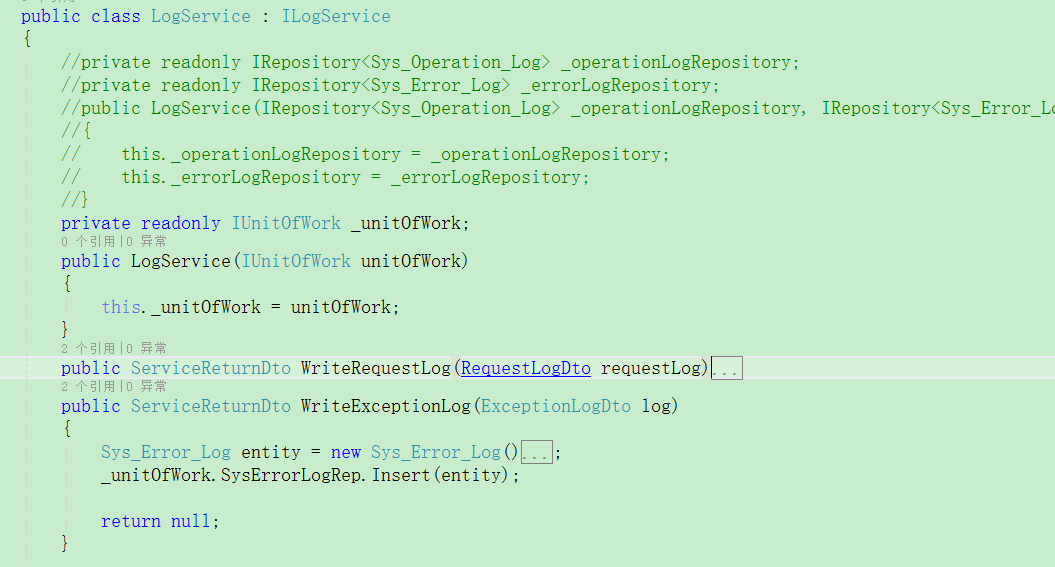
7.Service的动态注册
public static class AutoIocRegister
{
/// <summary>
/// 动态注入IOC,注意类和接口的命名规则,接口在类名前面加"I"
/// </summary>
/// <param name="services"></param>
/// <param name="assemblyName">程序集名称</param>
public static void BatchAddScoped(this IServiceCollection services, string assemblyName)
{
var libs = DependencyContext.Default.CompileLibraries;
var serviceLib = libs.Where(c => c.Name.Contains(assemblyName)).FirstOrDefault();
var assembly = AssemblyLoadContext.Default.LoadFromAssemblyName(new AssemblyName(serviceLib.Name));
var serviceClassList = assembly.GetTypes().Where(c => c.IsClass).ToList();
foreach (var item in serviceClassList)
{
var interfaceName = "I" + item.Name;
var interfaceType = assembly.GetTypes().Where(c => c.IsInterface && c.Name == interfaceName).FirstOrDefault();
if (interfaceType == null) continue;
services.AddScoped(interfaceType, item);
}
}
}
调用:
services.BatchAddScoped("Cloud.Service");
8.日志记录:
日志分操作日志和错误日志,可以设置在数据库和文本中同时记录:
通过全局过滤器GlobalExceptionFilter和GlobalAuthorizeFilter处理
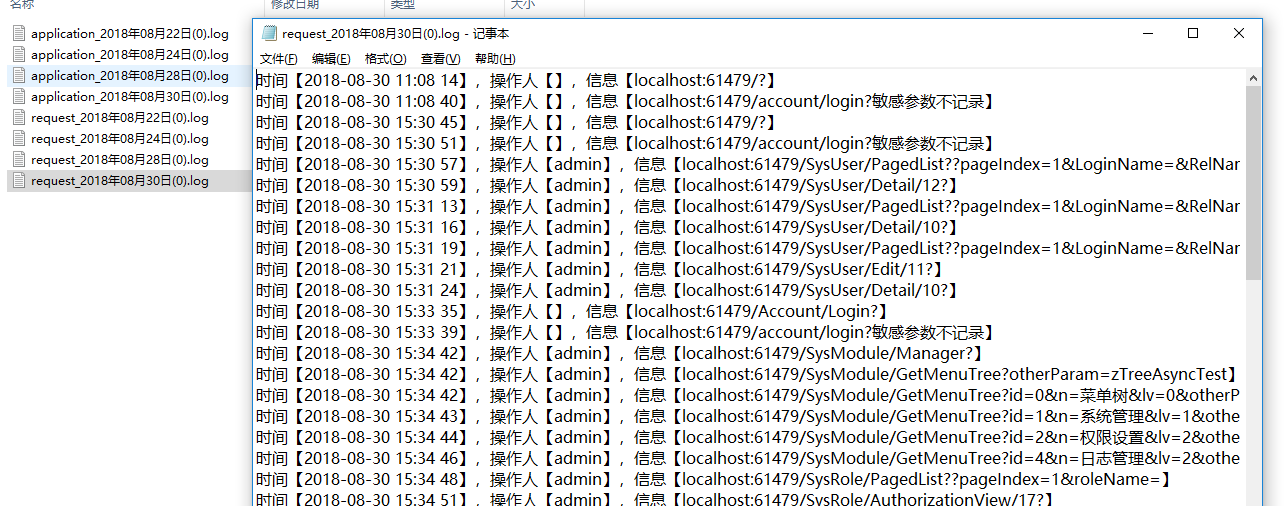
9.前端的封装(分页、弹出层、ajax等)
先放几张图吧,详细的以后再介绍
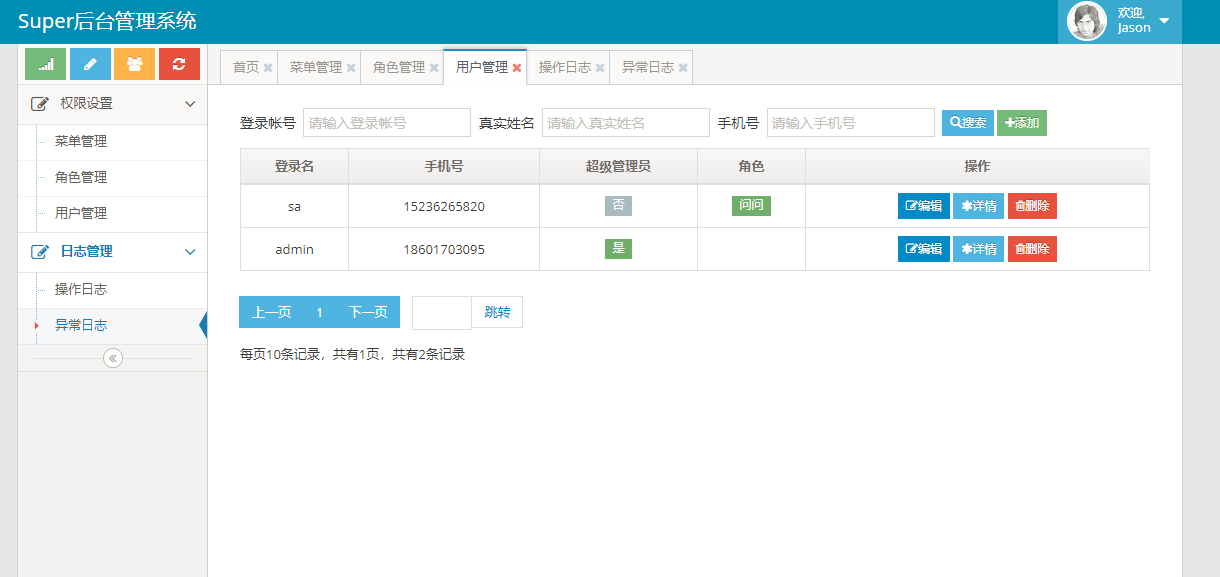



 浙公网安备 33010602011771号
浙公网安备 33010602011771号